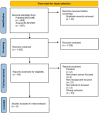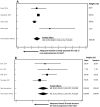Impact of Vitamin D Levels on Progression-Free Survival and Response to Neoadjuvant Chemotherapy in Breast Cancer Patients: A Systematic Review and Meta-Analysis
- PMID: 39766105
- PMCID: PMC11674590
- DOI: 10.3390/cancers16244206
Impact of Vitamin D Levels on Progression-Free Survival and Response to Neoadjuvant Chemotherapy in Breast Cancer Patients: A Systematic Review and Meta-Analysis
Abstract
Background: Breast cancer remains the leading cause of cancer-related deaths among women despite advances in early detection. Neoadjuvant chemotherapy (NACT) is now standard for early-stage BC, with vitamin D (VD) emerging as a potential prognostic biomarker considering its positive pleiotropic effects. This review and meta-analysis assess the impact of baseline VD levels on outcomes in BC patients undergoing NACT. Methods: Inclusion criteria required patients to be over 18 years of age, have a pathologically confirmed BC diagnosis, and have their VD levels assessed prior to chemotherapy. Studies were included if they reported odds ratios (ORs) for response and/or hazard ratios (HRs) for PFS with 95% confidence intervals (CIs). A comprehensive literature search of PubMed/MEDLINE and Scopus/ELSEVIER (2014-2024) was conducted, and data were analyzed using fixed- and random-effects models, with Forest plots illustrating the results. Study quality and potential biases were assessed using the MINORS, NOS, and RoB2 scales, and statistical heterogeneity was evaluated with I2 statistics and funnel plots. Results: Six studies were included in the analysis. All studies addressed stages II and III, with three also including stage I. The meta-analysis covered data from 722 patients regarding NACT response and 1033 patients for PFS. The results revealed a 22% reduction in the likelihood of non-response to NACT associated with adequate VD levels (low/deficient VD vs. high/sufficient VD; OR: 0.78; 95% CI: 0.30-1.25; p = 0.001) and a 35% reduction in progression risk with sufficient baseline VD levels (low/deficient VD vs. high/sufficient VD; HR: 0.65; 95% CI: 0.33-0.97; p < 0.001). Conclusions: These findings highlight the significance of maintaining adequate vitamin D levels in BC treatment and encourage further studies to unravel the role of VD on cancer biology.
Keywords: breast cancer; meta-analysis; neoadjuvant therapy; progression-free survival; response; vitamin D.
Conflict of interest statement
The authors declare no conflicts of interest.
Figures



References
Publication types
LinkOut - more resources
Full Text Sources

